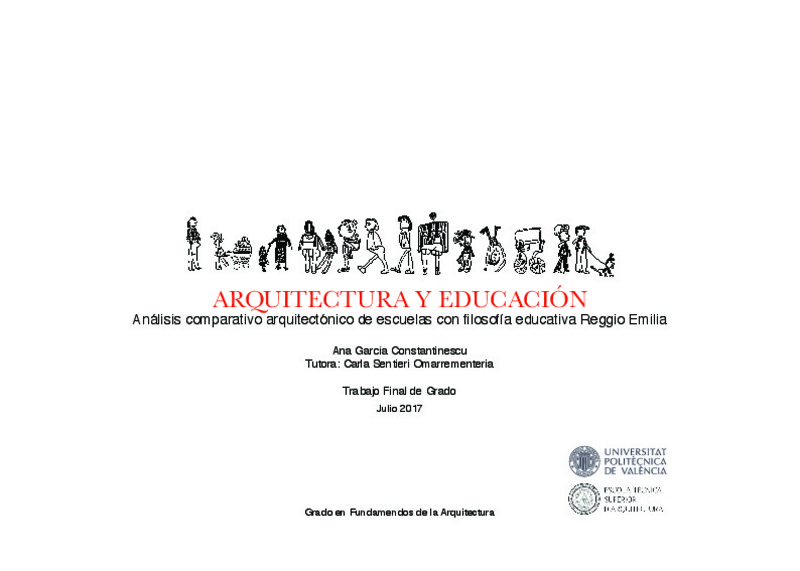JavaScript is disabled for your browser. Some features of this site may not work without it.
Buscar en RiuNet
Listar
Mi cuenta
Estadísticas
Ayuda RiuNet
Admin. UPV
Arquitectura y educación: análisis comparativo arquitectónico de escuelas con filosofía educativa Reggio Emilia
Mostrar el registro sencillo del ítem
Ficheros en el ítem
| dc.contributor.advisor | Sentieri Omarrementeria, Carla
|
es_ES |
| dc.contributor.author | García Constantinescu, Ana
|
es_ES |
| dc.date.accessioned | 2018-05-23T13:58:36Z | |
| dc.date.available | 2018-05-23T13:58:36Z | |
| dc.date.created | 2017-07-14 | |
| dc.date.issued | 2018-05-23 | es_ES |
| dc.identifier.uri | http://hdl.handle.net/10251/102465 | |
| dc.description.abstract | [ES] El trabajo plantea el análisis de escuelas donde se utiliza el método Reggio Emilia, con el objetivo de establecer los requisitos funcionales y espaciales para el aprendizaje con este método. La ciudad italiana de Reggio Emilia posee uno de los sistemas de educación infantil más innovadores y de mayor calidad del mundo, donde la relación que se establece entre pedagogía y arquitectura es necesaria para comprender su filosofía. El ambiente es considerado el tercer educador. Inspirada por las ideas de múltiples pensadores y pedagogos, la experiencia de Reggio Emilia va más allá de ser una mezcla aleatoria de teorías. Las escuelas reggianas se caracterizan por ser lugares democráticos, adaptables a su tiempo y situación y abiertos a la comunidad y las familias. Es decir, edificios flexibles, horizontales y transparentes. La imagen que se tiene del niño es determinante para la creación de los espacios: los niños son seres sociales, con sus propios derechos, seres que investigan y construyen su propio conocimiento gracias a espacios y situaciones que se lo permitan. También el papel del educador es importante: es un constante investigador, documenta y reflexiona sobre los acontecimientos del día a día y hace de guía al alumno generando situaciones de aprendizaje. Las escuelas con filosofía Reggio Emilia son lugares amables, bellos y con un gran sentido estético. | es_ES |
| dc.description.abstract | [EN] The Italian city of Reggio Emilia sites one of the most innovative and high-quality pre-primary education systems in the world, where the relation between pedagogy and architecture becomes necessary to understand their philosophy. The atmosphere is considered the third educator. Inspired by many pedagogues' ideas, the Reggio Emilia approach is more than just a random mix of theories. The Reggio infant-toddler schools are democratic places that should be adaptable to their context of place and time, as well as opened to the community and the families. That is to say, they are flexible, horizontal and transparent buildings. The image and role of the learner is decisive for the design of the spaces: children are social beings with their own rights. They are researchers that seek and build their own knowledge thanks to the spaces and situations they find along the school. The role of the instructor is also important: he is a constant researcher, he collects and analyses the everyday life and becomes the guide and facilitator for the child in the process of learning. The Reggio Emilia Approach schools are friendly and beautiful places, with a strong sense of the aesthetic. | es_ES |
| dc.format.extent | 80 | es_ES |
| dc.language | Español | es_ES |
| dc.publisher | Universitat Politècnica de València | es_ES |
| dc.rights | Reserva de todos los derechos | es_ES |
| dc.subject | Architecture for education | es_ES |
| dc.subject | Schools | es_ES |
| dc.subject | Reggio Emilia Approach | es_ES |
| dc.subject | Childhood | es_ES |
| dc.subject | Arquitectura escolar | es_ES |
| dc.subject | Escuelas | es_ES |
| dc.subject | Método Reggio Emilia | es_ES |
| dc.subject | Infancia | es_ES |
| dc.subject.classification | PROYECTOS ARQUITECTONICOS | es_ES |
| dc.subject.other | Grado en Fundamentos de la Arquitectura-Grau en Fonaments de l'Arquitectura | es_ES |
| dc.title | Arquitectura y educación: análisis comparativo arquitectónico de escuelas con filosofía educativa Reggio Emilia | es_ES |
| dc.type | Proyecto/Trabajo fin de carrera/grado | es_ES |
| dc.rights.accessRights | Abierto | es_ES |
| dc.description.bibliographicCitation | García Constantinescu, A. (2017). Arquitectura y educación: análisis comparativo arquitectónico de escuelas con filosofía educativa Reggio Emilia. http://hdl.handle.net/10251/102465 | es_ES |
| dc.description.accrualMethod | TFGM | es_ES |
| dc.relation.pasarela | TFGM\60012 | es_ES |
Este ítem aparece en la(s) siguiente(s) colección(ones)
-
ETSA - Trabajos académicos [4687]
Escuela Técnica Superior de Arquitectura






